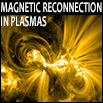Speaker
Dr
Shiyong Huang
(Laboratoire de Physique des Plasmas, CNRS-Ecole Polytechnique-UPMC, Palaiseau, France)
Description
Magnetic reconnection is a fundamental physical process that enables the rapid transfer of
magnetic energy into plasma kinetic and thermal energy in the laboratory, astrophysical and space
plasma. Flux ropes have been suggested to play important role in controlling the micro-scale
physics of magnetic reconnection and electron acceleration. In this presentation, we report the
observations of flux ropes associated with magnetic reconnection in the magnetotail based on the
Cluster multi-spacecraft data. Firstly, two consecutive magnetic flux ropes, separated by less than
30 s (Δt < 30 s), are observed within one magnetic reconnection diffusion region without strong
guide field. In spite of the small but non-trivial global scale negative guide field (–By), there exists a
directional change of the core fields of two flux ropes, i.e. –By for the first one, and +By for the
second one. This is inconsistent with any theory and simulations. Therefore, we suggest that the
core field of flux ropes is formed by compression of the local preexisting By, and that the directional
change of core field is due to the change of local preexisting By. Such a change in ambient By
might be caused by some microscale physics. Secondary, we will present in-situ observations of a
small scale flux rope locally formed at the separatrix region of magnetic reconnection without large
guide field. Bidirectional electron beams (cold and hot beams) and density cavity accompanied by
intense wave activities substantiate the crossing of the separatrix region. Density compression and
one parallel electron beam are detected inside the flux rope. We suggest that this flux rope is locally
generated at the separatrix region due to the tearing instability within the separatrix current layer.
This observation sheds new light on the 3D picture of magnetic reconnection in space plasma.
Author
Dr
Shiyong Huang
(Laboratoire de Physique des Plasmas, CNRS-Ecole Polytechnique-UPMC, Palaiseau, France)
Co-authors
A. Retino
(Laboratoire de Physique des Plasmas, CNRS-Ecole Polytechnique-UPMC, Palaiseau, France)
A. Vaivads
(Swedish Institute of Space Physics, Uppsala, Sweden)
D. D. Wang
(School of Electronic Information, Wuhan University, Wuhan, China)
F. Sahraoui
(Laboratoire de Physique des Plasmas, CNRS-Ecole Polytechnique-UPMC, Palaiseau, France)
G. L. Li
(Space Science Center, University of New Hampshire, Durham, New Hampshire, USA)
H. Karimabadi
(University of California San Diego, La Jolla, California, USA)
H. S. Fu
(Space Science Institute, School of Astronautics, Beihang University, Beijing, China)
M. Zhou
(Institute of Space Science and Technology, Nanchang University, Nanchang, China)
S. Fu
(School of Electronic Information, Wuhan University, Wuhan, China)
T. D. Phan
(Space Sciences Laboratory, University of California, Berkeley, California, USA)
W. Daughton
(Los Alamos National Laboratory, Los Alamos, New Mexico USA)
X. H. Deng
(Institute of Space Science and Technology, Nanchang University, Nanchang, China)
Y. Pang
(Institute of Space Science and Technology, Nanchang University, Nanchang, China)
Z. G. Yuan
(School of Electronic Information, Wuhan University, Wuhan, China)

